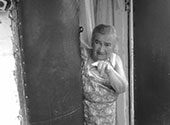
Sofia Geller was born in 1929 in Bratlsav. Her father worked as a coachman before the war. During the war, she evacuated to Central Asia, where she worked in a collective farm. When she returned to Bratslav after the war, she worked in the city council. She is married to Dovid Geller. She and Dovid have two daughters who live in Moscow.
Other Interviews:
KrishmeleyenenHebrew - the Language of Prayer
Bratslav Matchmaking
"we need to have a wedding!"
With Horse and Wagon to Donbas
Bratslav, Ukraine
In the first days of the war, the Soviet government in Moscow established an Evacuation Council, initially headed by Lazar Kaganovich, the Commissar of Transportation who himself had been born and raised in a small shtetl near Kiev. The Council was responsible for coordinating the orderly relocation of critical industrial and consumer infrastructure from the warzone to the Russian interior, where it was imagined industrial output could be preserved with limited interruption. The Council privileged the evacuation of people and entities that were crucial for the military and industrial needs of the state, singling out engineers, workers in factories critical for industrial and military output, youth fit for military service, and state and party elites. Family members of those individuals fitting into these categories were later added to the list. No specific provisions were made for the evacuation of the rest of the civilian population, and at no point was the evacuation of the Jewish population prioritized, despite the mortal danger Jews who fell under German rule faced. The Council also adopted a scorched earth policy, ordering the destruction of all valuable resources that could not be evacuated, so that the enemy—not to mention the civilians caught under enemy rule—would be deprived of even the most basic necessities.
The lack of official sanction and governmental assistance in preparing for evacuation, though, did not stop hundreds of thousands of Jews from fleeing in advance of the German army. Many Jews were able to evacuate as part of the official evacuation because they were represented among the state and party elite or other categories scheduled for evacuation.
These chosen evacuees were often able to bring along family members and even friends on the special trains allocated for this purpose. As word of the atrocities being committed to the west spread, though, most Jews recognized the necessity of flight and took desperate measures to flee. Those who did not make the official list took what they could and headed east. Many Jews had to use their own initiative to evacuate without government assistance. In this clip, Sofia Geller, then Dikkerman, describes how her father, who was a coachman, was able to transport his family out of Bratslav in his wagon, eventually making it to Lugansk.
Outside of immediate danger, those with specialized training were placed in factories to serve the military or industrial mission of the state. Those without industrial or military training were usually put to work on collective farms. As Sofia explains, her family initially in a kolkhoz in Lugansk.
But when the Germans approached Lugansk, the family was forced to evacuate further, traveling in freight trains to Tashkent, and eventually to a town by the Iranian border, where they worked on a kolkhoz for the remainder of the war.
Source: Jeffrey Veidlinger, In the Shadow of the Shtetl: Small-Town Jewish Life in Soviet Ukraine (Indiana University Press, 2013)
